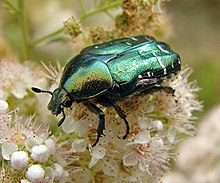
The family Scarabaeidae, as currently defined, consists of over 35,000 species of beetles worldwide; they are often called scarabs or scarab beetles. The classification of this family has undergone significant change in recent years. Several groups formerly treated as subfamilies have been elevated to family rank, and some reduced to lower ranks. The subfamilies listed in this article are in accordance with those in Catalog of Life (2023).

Buprestidae is a family of beetles known as jewel beetles or metallic wood-boring beetles because of their glossy iridescent colors. Larvae of this family are known as flatheaded borers. The family is among the largest of the beetles, with some 15,500 species known in 775 genera. In addition, almost 100 fossil species have been described.
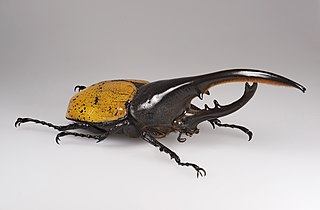
The Hercules beetle is a species of rhinoceros beetle native to the rainforests of southern Mexico, Central America, South America, and the Lesser Antilles. It is the longest extant species of beetle in the world, and is also one of the largest flying insects in the world.

The noble chafer is a species of beetles belonging to the family Scarabaeidae, subfamily Cetoniinae.

Dynastes tityus, the eastern Hercules beetle, is a species of rhinoceros beetle native to the Eastern United States. The adult's elytra are green, gray or tan, with black markings, and the whole animal, including the male's horns, may reach 60 mm (2.4 in) in length. The larvae feed on decaying wood from various trees.

Cotinis nitida, commonly known as the green June beetle, June bug or June beetle, is a beetle of the family Scarabaeidae. It is found in the eastern United States and Canada, where it is most abundant in the South. It is sometimes confused with the related southwestern species figeater beetle Cotinis mutabilis, which is less destructive.

Melolonthinae is a subfamily of the scarab beetles. It is a very diverse group; distributed over most of the world, it contains over 11,000 species in over 750 genera. Some authors include the scarab subfamilies Euchirinae and Pachypodinae as tribes in the Melolonthinae.

Macrodactylus subspinosus is a North American beetle of the family Scarabaeidae. The members of its genus are known as "rose chafers", not to be confused with the European rose chafer, Cetonia aurata. M. subspinosus occurs from Eastern Canada to Colorado and is considered a pest of many crops and flowers. It is given its common name of rose chafer because it eats the leaves of roses, although it also feeds on many other plants.
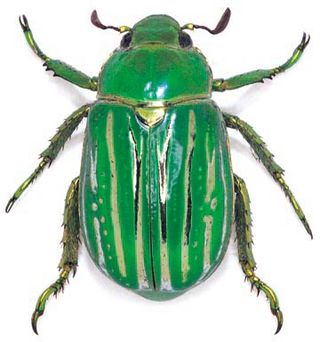
Chrysina gloriosa is a species of scarab whose common names are glorious beetle and glorious scarab. It is found only in southern United States and northern Mexico. The adult beetles, which are active both day and night and primarily seen from June to August, eat juniper leaves and the larvae feed on decaying wood from Arizona sycamore. A synonym formerly used for the species is Plusiotis gloriosa.

Heterorhina elegans is a species of Scarab beetle found in India and Sri Lanka that belongs to the flower chafer subfamily. Its genus name is frequently misspelled as "Heterorrhina". The adults are about 2 to 3 cm long and are usually bright glassy green appearing reddish at some angles. The clypeus is narrow and there is a ridge along the middle. They are seen in aggregations made up of large numbers in southern India during June to October.

The European chafer is a beetle of the family Scarabaeidae. Formerly found only in continental Europe, this invasive species is now found at temperate latitudes in North America. The large, white grubs of A. majale feed on the roots of most cool-latitude grasses, both wild and cultivated. This has made the European chafer an enemy of lawns.

Gastrophysa viridula, known as the green dock beetle, green dock leaf beetle or green sorrel beetle, is a species of beetle native to Europe.
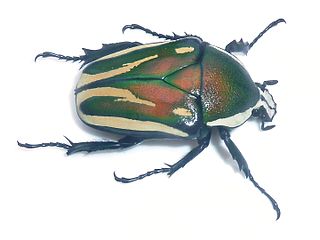
Dicronorhina derbyana, or Derby's flower beetle, is a sub-Saharan species of flower chafer.

Phyllopertha horticola, the garden chafer or garden foliage beetle, is a beetle from the family Scarabaeidae. Phyllopertha horticola was described by Carl Linnaeus in his landmark 1758 10th edition of Systema Naturae.
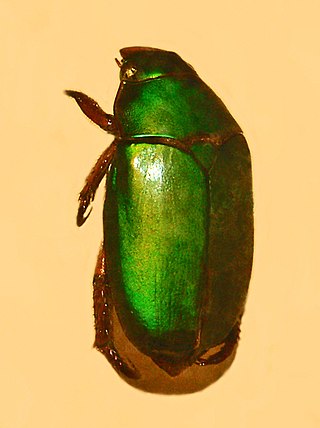
Calloodes rayneri, the green scarab beetle or Christmas beetle, is a species of shining leaf chafers of the family Scarabaeidae.

Pyronota festiva, commonly known as mānuka beetle or mānuka chafer, is a member of the genus Pyronota of the beetle family Scarabaeidae. It is a scarab beetle endemic to New Zealand, and is commonly found in mānuka trees, hence the beetle's name. In some areas it is considered a pasture pest.

Chrysina limbata is a species of scarab beetle found only in mid-altitude forests in Costa Rica and western Panama. It is in the genus Chrysina, in the subfamily Rutelinae. It is notable for its metallic reflective silver color.

Elater ferrugineus, the rusty click beetle, is a species of click beetle belonging to the family Elateridae.
Adoretus versutus, commonly known as rose beetle, is a species of shining leaf chafer found in Afro-Oriental tropics.
Anomala sulcatula, commonly known as the Philippine chafer, is a species of shining leaf chafers in the genus Anomala. It is considered as a pest as its larvae feed on sugarcane, rice, corn and maize.
